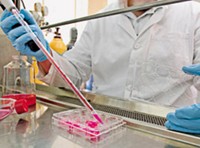Advertisement
Grab your lab coat. Let's get started
Welcome!
Welcome!
Create an account below to get 6 C&EN articles per month, receive newsletters and more - all free.
It seems this is your first time logging in online. Please enter the following information to continue.
As an ACS member you automatically get access to this site. All we need is few more details to create your reading experience.
Not you? Sign in with a different account.
Not you? Sign in with a different account.
ERROR 1
ERROR 1
ERROR 2
ERROR 2
ERROR 2
ERROR 2
ERROR 2
Password and Confirm password must match.
If you have an ACS member number, please enter it here so we can link this account to your membership. (optional)
ERROR 2
ACS values your privacy. By submitting your information, you are gaining access to C&EN and subscribing to our weekly newsletter. We use the information you provide to make your reading experience better, and we will never sell your data to third party members.
Biological Chemistry
Turning Back a Cell's Clock
Harvard scientists use embryonic stem cells to reprogram adult skin cells
by Susan R. Morrissey
August 29, 2005
| A version of this story appeared in
Volume 83, Issue 35

STEM CELL RESEARCH
For the first time, researchers have been able to reprogram adult somatic cells to behave like human embryonic stem cells (ESCs) by simply fusing the somatic cells with ESCs from existing stem cell lines (Science 2005, 309, 1369).
ESCs are of interest because of their potential to form replacement cells and organs for disease treatment. Until now, published methods to derive ESCs all have involved direct destruction of an embryo. This new process will help scientists understand details about how adult cells can be transformed back to ESCs--information that could provide less ethically charged alternatives to somatic cell nuclear transfer (or therapeutic cloning) for deriving stem cell lines.
Word of this new process comes as Congress debates the need to expand the federal ESC research policy, which allows federally funded research on a limited number of stem cell lines. The House has already passed legislation to allow federal funds to be used to study additional ESC lines derived from excess in vitro fertilization embryos. The Senate is expected to vote on similar legislation next month.
Regardless of congressional support for changing the policy, President George W. Bush has vowed to veto any legislation easing the research restrictions.
The work, reported by Harvard University researchers Chad A. Cowan, Jocelyn Atienza, Douglas A. Melton, and Kevin Eggan, used ESCs from existing cell lines that were genetically engineered to carry an antibiotic-resistance gene. Using polyethylene glycol, the group fused these cells with adult skin cells that were genetically engineered to carry a different antibiotic-resistance gene.
The mixture was then placed in conditions known to be favorable to ESC growth and in the presence of the two antibiotics to ensure that only fused cells that contained both resistance genes would survive. The cells were allowed to grow, giving rise to colonies indicative of ESCs.
"We did a battery of experiments to show that indeed [the hybrid cells] carried the genes of both the adult cell and the ESC," Eggan said during a teleconference. "By every battery of assays that we have for testing ESCs, we saw that these hybrid cells looked just like ESCs," he noted, adding that the activity of the genes from the adult cell was found to be transformed to an embryonic state.
These hybrid cells still face "substantial technical barriers" in that they contain genetic material from both the original ESCs and the adult somatic cells. For hybrid cells to be therapeutically useful, researchers must find a way to remove the unwanted ESC genes.
As Eggan and his colleagues work toward understanding how cell reprogramming works and developing new ways to create therapeutically viable stem cells, Eggan says that the derivation of new ESC lines should continue. "I remain a very strong supporter of the proposed legislation in the Senate, and I hope it will move forward."



Join the conversation
Contact the reporter
Submit a Letter to the Editor for publication
Engage with us on Twitter